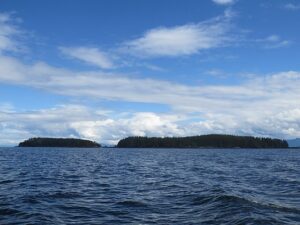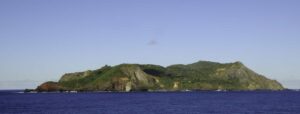It is with some trepidation that I approached the second issue of Some Islands, not least because it was described to me as a journal about linguistics, art, and architecture. My training in these fields causes me to tense up with a conscientious undergraduate’s panic about not having studied for the exam. My trepidation was amplified when I saw that Lingoblog’s review of the previous issue was also beautifully illustrated by Miša Hejná, also a contributor to the present issue — something I have not braved in the present review.
The theme, representation, conjures half-remembered memories of lectures in semantics that I’m sure were also only half-understood. So, perhaps, as befits the issue’s theme of representation, it’s best to begin discuss relationship of representation to the form of the journal constructed as a web-site.

Contributors are arranged alphabetically by first name in a column on the left of the page, but given the form, one is tempted and even encouraged, into ambling through articles, creating the reader’s own relation to the content. Therefore, I cannot say what another reader will take from the journal, but I can recount my own journey through these islands. If my intention as a conscientious reviewer was to read the whole front-to-back, my curiosity drove me to re-read, to click through in non-linear paths. I visited some literal islands on this journey, from Tasmania to the Canadian Arctic and Pitcairn (twice), and each article also reads, at first, like something of an island onto itself.
If each article is an island, the journal itself is more, to use editor Joshua Nash’s word, ‘amorphous,’ something of an archipelago of artifacts through different media, a landform that morphs and adapts to each reader. Brett Cranswick’s contribution is a sonnet constructs a collective ‘we’, who is ‘cast on the sea’:
We
Found broadside berths less comfort possibly
Than sinking leagues deep, finding home at last.
And this image of being cast upon the sea is akin to navigating the islands here, but the ‘we’ invites the reader along on the journey. Island scholar Godfrey Badacchino’s writes about the ‘trick of mapping’ and the porousness of a boundary that is usually constructed as a simple inside/outside binary, something we take along as each article bleeds into another; the reader’s path connects the various articles in constructing the multiplicity of signification here. Nash’s afterword describe the issue as a ‘nexus of productive infinities,’ multiplying the small collection of articles in relation to greater collective enunciation in other issues of the journal, but also the community of authors and readers within: the ‘we’ of Cranswick’s poem collected by the various tendrils of the journal itself.
The twenty-five contributions come from a diversity of authors and fields, and in forms that are occasionally prosaic or pretentious, but more often than not profound. The reader encounters linguists, island scholars, architects, artists, musicians, and scientists. The reader also finds artifacts of representation in different registers of text — from the scientific article to fiction and poetry, but also photos, drawings, paintings, musical recordings, and even a few animated GIFs. Each contribution is as uniquely personal as much as it is enlightening. Still, Nash calls the articles ‘peer-reviewed,’ and this seems true more for their role as editor rather than in following established scientific writing practices; indeed, the issue shows what bright minds can be dulled into obscure and flaccid prose of the scientific journal.

Perhaps, as befits the topic of islands, one theme that emerges is isolation; one gets the sense of each author on their island, whether a disciplinary silo or literal isolation, searching for forms of connection.
Adrian Young takes an outsider’s perspective on their discipline in recalling non-western temporalites in asking what an historian owes the dead. Fiona Sprott confronts the psychological isolation of addiction and the ghost’s of one’s past. Helen Bromhead is isolated in the air-conditioned bubble of their apartment while writing about the language of extreme heat in Australia. Even still, we begin to make unlikely but poignant connections as Bromhead is answered in Rebecca Taylor’s discussion of the language of water-sensitive urban design in Adelaide.
The theme goes on: Ken Bolton offers narrative poems of quarantine in Hobart writing about art that is far away and a virus that is also strangely distant. Several authors tackle the isolation of humans in relation to ‘nature,’ whether caught it is caught in a tangle of representations, as Ole Wich’s discussion of tourist literature about the Faroe islands, or viewed with romantic envy, as Oliver Rozsnay’s article about birds, or Olive Nash’s photos of ‘nature’ showing highly adulterated, though also strangely mundane industrial landscapes.
We also see that isolation has its corresponding moments of connection – Aleš Rajch writes of his oboe teacher Jiři Tachibudek, an island of central European culture in Australia, in a moving tribute accompanied by beautiful recordings of several pieces of music. One might be tempted to think, like the syntactic islands of Rebekah Baglini’s offering, that each article prohibits ‘movement operations’ — that shuffling the syntax of the whole would leave each isolated, or that it would be impossible to construct significance or shared points of reference. However, the journal rather reveals itself is a vehicle to construct bridges instead; as a reader, my path begins to weave connections between different texts, pulled along as much by the affective force of the articles as by my own curiosity. One of Peter Bakker’s contributions notes that almost none of the world’s language isolates are spoken on islands, but that many form creoles — natural languages that develop from the contact of two or more languages. These take some vocabulary from the language of the politically dominant group, but as Bakker points out, are incredibly creative in the grammars which structure these languages. Each of the articles in Some Islands 2 invites the reader to construct new languages in these sites of seeming isolation, multiplying significance between each article and within themselves.
Despite a background in literature and linguistics, Joel Letkemann is currently assistant professor of sustainable architecture at Aalborg University. His abandonment of the humanities, however, is far from a betrayal, as his research interests continue to engage with themes of science fiction and global futurisms with a critical perspective informed by feminist, queer, decolonial, and ecological perspectives.







